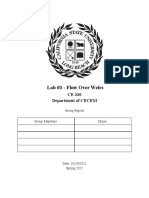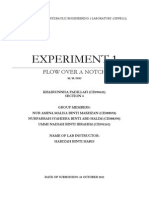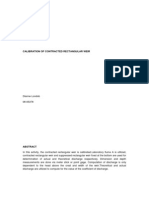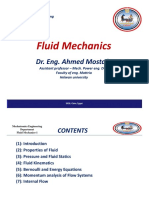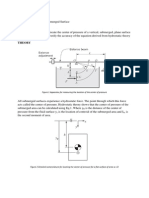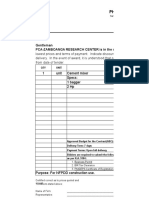Design Analysis of Flow Over Rectangular Channel
Uploaded by
siddharth chandraDesign Analysis of Flow Over Rectangular Channel
Uploaded by
siddharth chandraDesign and Analysis of Flow over Inclined weirs in Rectangular Open Channels
CHAPTER 2
LITERATURE REVIEW
2.1 Weirs:
A comprehensive literature survey has been done pertaining to the
flow behavior of normal and side weirs; majority of these studies have
been reviewed in this chapter.
2.1.1 Normal Weirs:
Kandaswamy and Rouse (1975) was the first to provide the following
equation for the discharge Q over a normal weir:
2
Q = C d Lh 2 gh ...2.1
3
where C d = discharge coefficient; L = length of weir ; g= gravitational
acceleration ; and h = head above crest.
Bezin & Rehboc (1929) gave the following equation for discharge
coefficient:
C d = 0.6075 + 0.334[h/(h+w)] ...2.2
where w = height of the weir in question.
Frazer & Rehbock (1930) presented the following equation for
discharge coefficient:
C d = 0.615 + 0.338[h/(h + w)] 2 ...2.3
Swiss Society for Engineers and Architects, Rehbock proposed the
following equations for C d :
C d = 0.615 + 0.308[h/(h+w)] 2 ...2.4
Rehbock (1929) proposed the following formula for C d :
C d = 0.605 + 0.08 h/w ...2.5
Kandaswamy and Rouse (1975) proposed following equations for
weir and sill range respectively:
Manipal University, Manipal Page 7
Design and Analysis of Flow over Inclined weirs in Rectangular Open Channels
C d = 0.61 + 0.08h/w ; for 0 < h/w < 6 ...2.6
C d = 1.06[1 + w/h] 3 / 2 ; for 0 < w/h < 0.6 ...2.7
Govinda Rao and Muralidhar (1962) have conducted analysis of
experimental data on rectangular and triangular notch weirs and have
successfully established the curve between C d and wetted perimeter.
Smith and Liang (1969) carried out experimental study on
triangular broad crested weir and gave a plot of discharge coefficient Vs
H/L, in which, H in Head above crest and L is the length of broad crested
weir. This set of experiments proved vital in further studies.
Srinivasalu and Raghavendran (1970) proposed proportional weir with
parabolic bottom. An average discharge coefficient as obtained by them is
0.63. The profile obtained by the investigators is as shown in Fig.2.1. The
parabolic bottom remained to be analysed.
Rao and Shukla (1971) have established following equations for the
discharge coefficient for weir of rectangular cross section of finite crest
width as
h h
Cd = 0.482 + 0.02 ; For = 0.08 ...2.8a
p B
h h
Cd = 0.527 + 0.049 ; For = 1.0 ...2.8b
p B
h h
Cd = 0.578 + 0.061 ; For = 1.6 ...2.8c
p B
h h
Cd = 0.611 + 0.08 ; For > 1.6 ...2.8d
p B
where h = head over weir; p = weir height; B = weir width.
Manipal University, Manipal Page 8
Design and Analysis of Flow over Inclined weirs in Rectangular Open Channels
Fig. 2.1 Proportional Weir with Parabolic Base (Shrinivasalu et al.1970)
Chandrasekaran and Lakshmana Rao (1984) designed and carried out
experimental study on proportional weirs with a segment of a circle at
bottom and reported that circular bottom does not affect the value of the
coefficient of discharge.
Keshava Murthy and Pillai (1986) have designed linear proportional
weirs having compound base weir. The discharge coefficient is varying
from 0.625 to 0.631. Further, they have shown that C d increases as W/a
decreases for rectangular base weirs and the discharge coefficient has
minor variation with respect to head for quite a large range of head (0.15 ≤
H c / P ≤ 2.5).
Boiten and Pitlo (1982) have derived the head discharge relations
for different shapes of broad crested V-weir under free flow as well as
submerged flow conditions. In their study they have shown that C d
increases with h/l ratio with the increase in angle of V-notch.
Mansur, (1999) obtained the following equation in terms of
channel width to weir length ratio and head to weir height ratio for the
Manipal University, Manipal Page 9
Design and Analysis of Flow over Inclined weirs in Rectangular Open Channels
experimental values of Kindswater and Carter (1957) as
0.7 1.46
B B
0.611 + 2.23 -1 0.075 - 0.011 -1
b b h ...2.9
Cd = 0.7
+ 1.46 w
B B
1 + 3.8 -1 1 + 4.8 -1
b b
Swamee (1988) obtained the following full range equation for sharp
crested weirs using the experimental data of Kandaswamy and Rouse
(1975):
-0.1
14.14 w 10 h 15
C d = 1.06 + ...2.10
8.15 w + h h + w
Swamee (1998) obtained the following expression for discharge
coefficient based on the experimental data on broad crested weir by
Govinda Rao and Muralidhar (1962).
Long Crested weir:
0.5
h h
Cd =0.5 + 0.1 ; ≤ 0.1 ; ...2.11a
L L
Broad Crested Weir:
0.2
h h
Cd = 0.5 + 0.05 ; 0.1 ≤ ≤ 0.4 ; ...2.11b
L L
Narrow Crested Weir:
h h
C d = Cd = 0.5 + 0.11 ; 0.4 ≤ ≤ 1.5 ...2.11c
L L
Also gave full range equation to all types of rectangular weirs as
10 15
1.140w h
Cd = 1.06 +
8.15w + h h + w
−10
h 5 13 0.1
0.1
h
+ 1500
L L
+ 1834 1 + 0.2 3 ...2.12
1 + 1000 h
L
Manipal University, Manipal Page 10
Design and Analysis of Flow over Inclined weirs in Rectangular Open Channels
Keshava Murthy and Giridhar (1989) proposed a simple geometrical
weir called inverted-V-notch or inward trapezium as a practical
proportional weir. They gave an equation for discharge as follows.
Q =0.448 LW 2Cd 2 gd ( h − 0.0817 d ) ...2.13
for the head range of 0.22d ≤ h ≤ 0.94d and reported that average coefficient
of discharge as 0.61 with an indication error of ± 1.5%.
Keshava Murthy and Giridhar (1990) developed a linear head
discharge relationship for chimney weir of the form
1
Q = 0.5227 P 2
(H − 0.1112 P ) ; 0.2993 P ≤ H ≤ 3.3061P ...2.14
where P=p/W; H=h/W
in which p=height of trapezium; h=head above weir crest; W=half width of
weir crest; and reported that discharge coefficient varies from 0.6 to 0.61.
Swamee, P.K. et al.,(1994) proposed an equation for discharge for
the alternate linear weir by considering C d (=0.92), as
Q=0.166 π b 0 h
Q = 0.166π bo h gh* ; h ≥ hmin ...2.15
where h m i n is 4h * ;h * = length parameter, b 0 = weir base width, h=head over
weir crest and g= gravitational acceleration.
Ramamurthy and Vo Ngoc-Diep (1993) have shown that C d
increases with the increase in downstream slope ( β ) for circular crested
weir, whereas any change in upstream slope does not alter C d (See
Fig.2.2).
Manipal University, Manipal Page 11
Design and Analysis of Flow over Inclined weirs in Rectangular Open Channels
Fig.2.2 Effect of Downstream Slope β On C d – (0<H 1 /R ≤ 25) (Ramamurthy
and Vo Ngoc-Diep.1993)
Chatterjee, et al., (2002) carried out experimental investigation for
chimney weir under submergence for different half vertex angle and half
crest width and found that the influence of w/y o is more than L/B on
discharge coefficient.
Jalili and Borghei (1999) have proposed the equation for discharge
coefficient for weirs in sub critical flow condition as
C d = 0.71-0.41F 0 - 0.22w/y 0 ...2.16
and pointed out that w/y 0 is an influential parameter, and as w/y 0 increases,
the outflow discharge decreases; hence w/y 0 should appear in the formula
with a negative sign.
Udaysimha, et al., (2000) investigated the effect of crest height and
width of IVN on coefficient of discharge using equation of discharge by
Murthy, Giridhar (1989). He reported that IVN attain a coefficient of
discharge of 0.59 to 0.60 for the range of widths and heights investigated
by them.
Manipal University, Manipal Page 12
Design and Analysis of Flow over Inclined weirs in Rectangular Open Channels
2.1.2 Side weir:
Flow through a channel having a side weir is in essence a spatially
varied flow problem. For a frictionless rectangular channel of bed width
B, the governing differential equation is
dy yQ dQ
= 2 2 3
...2.17
dx Q − gB y dx
where y = flow depth; and x = distance along the flow direction.
De Marchi (Henderson 1964) considered the following equation for
the discharge rate
dQ 2
= − C d ( y − w) 2 g ( y − w) ...2.18
dx 3
Further, using the following discharge equation expressed in terms of
specific energy E
Q = By 2 g ( E − y ) ...2.19
and using the above equation for dQ/dx, De Marchi Henderson (1964)
obtained the following differential equation:
dy 4 Cd ( E − y)( y − w)3
=− ...2.20
dx 3 B 2E − 3 y
Integrating between limits x = 0 and x = L, yielded the following solution:
2 E - 3w E - Ya E - Ya 2 E - 3w E - YO E - YO 2 Cd L
- 3sin -1 = - 3sin -1 + ...2.21
E - w Ya - w Ya - w E - w YO - w YO - w 3 B
where suffixes 0 and a denote the upstream and downstream ends of side
weir. Knowing Q 0 and Y 0 at the upstream end of side weir, Y a can be
obtained by trial and error and the discharge, Q a can be obtained. Thus, the
discharge over the side weir
Q = Q0 - Qa ...2.22
Q0
F0 = ...2.23
B. gy 3
Manipal University, Manipal Page 13
Design and Analysis of Flow over Inclined weirs in Rectangular Open Channels
Subramanya and Awasthy (1972) conducted experiments in a
rectangular channel with horizontal bed and related C d with the upstream
Froude number as:
C d = 0.864 (1-F02 )/(2+F02 ) ; for F o < 0.8 ...2.24a
C d = 0.36 - 0.08F 0 ; for F o > 2.0 ...2.24b
Yu-Tek proposed the following relationship for C d :
C d = 0.622 - 0.222F 0 ...2.25
Nadesamoorthy and Thomson (1972) obtained the following
equation for C d :
Cd = 0.432 (2 − Fo2 ) / (1 + 2Fo2 ) ...2.26
Ranga Raju, et al., (1979) gave the following equation for C d for
side weir in rectangular channel.
Y -W y −W
Cd = ( 0.81 − 0.6 Fo ) 0.80 − 0.1 1 ; for 1 2.0 ...2.27
L L
Where F 0 = u/s Froude number
Y 1 = flow depth in main channel at u/s end of weir
W = height of weir
L = length of weir crest.
Ranga Raju, et al., (1984) gave the following equation for C d :
C d = 0.54 - 0.4F 0 ...2.28
Uyumaz, Muslu (1985) based on the investigations of flow over
sharp edged side weirs in circular channels, proposed the following
equations for C d .
For sub critical regime:
L L
Cd =0.21 + 0.094 1.75 − 1 + 0.22 − 0.08 1.68 − 1 1 − F1 ...2.29a
D D
For supercritical regime:
Manipal University, Manipal Page 14
Design and Analysis of Flow over Inclined weirs in Rectangular Open Channels
L L
Cd =0.046 + 0.0054 1.67 − 1 F1 + 0.24 + 0.021 1 + 35.3 ...2.29b
D D
Singh, et. al. related C d with F o , Y 0 and w as :
C d = 0.33 - 0.18F 0 + 0.49w/Y 0 ...2.30
For a rectangular side weir with w = 0, Hager related C d with F 0 as:
(2 − F02 )
Cd = 0.485 ...2.31
(2 + 3F02 )
Kumar and Pathak (1987) have studied the discharge characteristics
of sharp and broad crested triangular side weirs of angles 60 o , 90 0 and
120 0 . Based on experimental investigation following equations have been
proposed.
Sharp crested weir of apex angle 60 0 :
Q = 0.5908C 2g tan θ /2 h 5 / 2 ...2.32a
Broad crested weir of apex angle 120 0 :
5
h θ 2
Q = Q =0.5566 0.80 + 0.10 C 2 g tan h ...2.32b
L 2
in which
θ θ θ θ
C = 0.811 − 0.321tan +0.129tan 2 - 0.695-0.638tan +0.150tan 2 F ...2.32c
2 2 2 2
Cheong proposed the following equation for C d for a trapezoidal
main channel:
C d = 0.45 - 0.22 F02 ...2.33
Swamee et al., (1994) considered the variation of flow depth along
the side weir and introduced the concept of elementary discharge
coefficient, C e , i.e. the discharge coefficient for the element of length dx.
Swamee, et al., (2000) gave the following equation for C e for sharp crested
weirs as
Manipal University, Manipal Page 15
Design and Analysis of Flow over Inclined weirs in Rectangular Open Channels
-0.15
44.7 6.67 h 6.67
C e = 0.447 +
w
...2.34
50+h w h w +1
Where ηw = (y-w)/w in which y = flow depth; w = weir height.
Borghei, et al., (1999) conducted experiments on sharp crested side
weir in sub critical flow in rectangular channel and related C d with the
variables F o , w/y 0 , L/B and S o . They proposed the first order polynomial
equation for discharge coefficient as
C d = 0.7 - 0.48F 0 - 0.3w/y 0 + 0.06L/B ...2.35
2.1.3 Skew Weir:
For a round crested skew weir, Aichel O.G. (1953) used the
equation for normal weir for computing the discharge and gave a table
relating the discharge coefficient of a skew weir to the discharge
coefficient of a normal weir. The tabular values can be converted to the
following equation:
1 h
C d = 1 − 1.17 (Cd )e= π ...2.36
1 + 3.7Q w 2
where θ = 2 θ / ( π -2 θ ). It is clear from the above equation that C d
increases with the increase in θ .
Considering the importance of existing broad crested skew weirs in
the field (Near Chennai, Tamil Nadu, India), Ganapathy, et al., (1964)
conducted experimental study and gave curves (See Fig.2.3) for C d versus
h with θ as third parameter, which are in conformity with the findings of
Aichel O. G. (1953).
Manipal University, Manipal Page 16
Design and Analysis of Flow over Inclined weirs in Rectangular Open Channels
Fig.2.3 Variation of C d with h (Ganapathy et al.1964)
Mohapatra P. K. (1964) presented an approach similar to Aichel O.
G. (1953) to determine the discharge coefficient for a rectangular sharp
crested skew terminal weir (weir followed by an outfall) and found that the
discharge coefficient of skew terminal weir is greater than the
corresponding discharge coefficient of skew weir.
Muralidhar D, (1965) conducted experiments on broad crested skew
weirs with θ = π /12, π /6, π /4, π /3 and 5 π /12 for 0.2066 ≤ h/w ≤ 0.902. He
considered the following discharge equation for a skew weir:
3/ 2
2 yF02
Q = Cd Lh 2 gh 1 + ...2.37
3 2h
The experimental results were presented in the form of C d /(C d ) θ =
π/12 versus h/c curves with θ as third parameter, where c = crest width.
These curves adhere to the following equation:
0.4 + 1.73Q c 0.2 + 1.7Q2 h
Cd = + 2 (Cd )θ = π ...2.38
1 + 1.73Q c + h 1 + 1.7Q h + C 2
Manipal University, Manipal Page 17
Design and Analysis of Flow over Inclined weirs in Rectangular Open Channels
Jain S C, Fischer (1982) designed a skew side weir, i.e. a side weir
with its crest oblique to the approach flow, to obtain almost uniform
discharge distribution over it by proper reduction in the width of channel.
For a side weir discharge Q, the reduced channel width B r was obtained as:
Q -Q
Br = 0 B ...2.39
Q0
2.1.4 Multifold Skew Weir:
A combination of skew weirs may be defined as multifold skew
weirs. Labyrinth weir is an example of a multifold skew weir.
Hay and Taylor (1970) studied various types of labyrinth weirs and
presented the results in the form of curves between the ratio of discharge
over labyrinth weir to corresponding normal weir and h/w.
Tullis, et al., (1995) studied labyrinth weirs having trapezoidal plan
forms with θ ranging from π /30 to 7 π /36 and presented the results in the
form of curves between C d and E/w with θ as third parameter.
2.1.5 Inclined Weir:
The papers published in journals mainly pertain to normal weir,
side weir, Skew weir and Multifold Skew weirs. Not enough work is
traceable in the literature on inclined weirs. Inclined weirs exhibit a
plethora of new characteristics which are yet to be studied and categorized.
Hence the present work is a leap in this area and sheds light on improving
discharge coefficient of geometrically simple but inclined weirs in
rectangular channels. Simple profiles have been considered in this work
because they can be fabricated easily and the mathematical model can be
built with simpler analytical methods.
Manipal University, Manipal Page 18
Design and Analysis of Flow over Inclined weirs in Rectangular Open Channels
2.2 Sluice Gate:
The review pertains to normal sluice gates, side sluice gates and
skew sluice gates.
2.2.1 Normal Sluice Gate:
The conventional sluice gate discharge equation is written as
Q = Cd aL 2 gy ...2.40
where a = gate opening; L=gate length; y=flow depth
Zohrab, S and Henry, M. (2000) gave C d versus y/a curves with y t /a
as third parameter, where Y t = tail water depth (See Fig.2.4 ).
Rajaratnam, N., and Subramanya, K.(1967) confirmed the findings of
Zohrab, S and Henry, M. (2000).
Swamee, P.K., et al., (1998) gave the following equations for
Henry’s curves for free and submerged flow respectively:
0.072
y-a
Cd = 0.611 ...2.41a
y+15a
-1
y-a
0.072 0.72
0.7
0.7 yt 0.7
Cd = 0.611 ( y-yf ) 0.32 0.81y t -y + ( y-y t ) ...2.41b
y+15a a
Ramamurthy, et al., (1978) through the limited experimental
investigation showed that the discharge coefficient C d increases (up to 1.5)
with an increase in Reynolds number for all values of d/a (range of R
studied is between 1.6x10 4 and 6.6x10 5 ) when cylindrical lip was attached
to the bottom of sluice gate. Where ‘d’ is the dia. of cylindrical lip and
‘a’ is the gate opening.
Swamee, P.K. et al., (1988) based on his experimental investigation
on rectangular slots, proposed a generalised flow equation as
2 a 1.5
Q = Cd bh 2 gh 1 − 1 − U ( h − a ) ...2.42a
3 h
where C d = discharge coefficient given by
Manipal University, Manipal Page 19
Design and Analysis of Flow over Inclined weirs in Rectangular Open Channels
1
k ( h − a ) U ( h − a ) Cd + a C n n
m m
g dw
...2.42b
m
k (h − a) U (h − a) + a m
wherein k, m and n = constants to be determined experimentally ; U = unit
step function; a=sluice gate opening ; b=gate length; g=gravitational
acceleration; h= operating head and C d g = gate discharge coefficient; C d w
= weir discharge coefficient.
Fig.2.4 Discharge Characteristics of Normal Sluice Gate.(Zohrab, S and
Henry, M.2000)
2.2.2 Side Sluice Gate:
Panda and Tanwar ( ) related the discharge coefficient to the
Froude number, the ratio of flow depth to the side sluice gate opening, and
the ratio of tail water depth to the side sluice gate opening. Panda studied
velocity distribution and water surface profile in main and side channels
under free and submerged flow conditions.
Mansoor, (1999) obtained experimental curves for C d , which is a
similar to Henry’s curve. Hager W H, Volkart P U (1986) proposed the
Manipal University, Manipal Page 20
Design and Analysis of Flow over Inclined weirs in Rectangular Open Channels
following equation for discharge variation along the side sluice gate for a
prismatic rectangular channel with nearly horizontal bed
0 .5
dQ a 2g
=
E 3 (4 E − 3 y )
dx
...2.43
in which a=gate opening; E=specific energy; y=flow depth;
g=gravitational acceleration; dQ/dx = discharge variation along the channel
length.
Using the concept of elementary discharge coefficient, C e , Swamee,
et al., (1991) gave the following equations for free and submerged flow
respectively:
0.216
y−a
Cd = 0.611 ...2.44a
y +a
-1
yt
0.67
0.216
y−a 2.5 yt a − y
Ce = 0.611 1 + 0.24 ...2.44b
y + a y − yt
Curves of C e are depicted in Fig.2.5
2.2.3 Skew Sluice Gate:
Swamee, et al.,(1993) using the functional form of C e as proposed by
Swamee for free and submerged flow conditions through a sharp crested
side sluice gate respectively as (See Fig:2.5)
k1
y−a
C e = k 0 Ce = ko ...2.45a
y + ka
-k 7
k5
6
k
y
k k 4 y t -y
t
y-a 2 a
And Ce = ko 1+k 3
...2.45b
y+k1a y-y t
Manipal University, Manipal Page 21
Design and Analysis of Flow over Inclined weirs in Rectangular Open Channels
Fig.2.5 Discharge Characteristics of Side Sluice Gate (Swamee et al.,
1993)
and using fourth order Runge Kutta method subjected to the initial
condition, by trial and error, the constants k 0 through k 7 are determined.
The variation of C e against y/a is plotted with y t /a as a third parameter.
Fig.2.6 shows one such graph drawn for skew angle, θ = π /4.
Manipal University, Manipal Page 22
Design and Analysis of Flow over Inclined weirs in Rectangular Open Channels
Fig. 2.6 Variation of C e with Y/A And Y t /a for θ = π /4(Swamee et
al., 1993)
2.2.4 Inclined Sluice Gate:
The review of literature failed to find any published work on
inclined sluice gate.
2.3 Concluding Remarks:
The reported literature on weirs mainly relates to broad crested
weirs and no substantial work has been reported in publication on sharp
crested weirs. It also reveals that no attempt is made on inclined sluice
gates by earlier investigators. This review clearly presents the fact that
inclined weirs have not been studied let alone implemented. This
emphasizes the importance of the present study. The work proposes to
design, implement and analyze inclined weirs with different profiles.
Manipal University, Manipal Page 23
Design and Analysis of Flow over Inclined weirs in Rectangular Open Channels
Manipal University, Manipal Page 24
Design and Analysis of Flow over Inclined weirs in Rectangular Open Channels
Manipal University, Manipal Page 25
You might also like
- De - Referral Hydraulics Lab Sheet Cousework - 2020-21yrNo ratings yetDe - Referral Hydraulics Lab Sheet Cousework - 2020-21yr14 pages
- Lab-2: Flow Over A Weir Objectives: Water Resources Engineering Jagadish Torlapati, PHD Spring 2017No ratings yetLab-2: Flow Over A Weir Objectives: Water Resources Engineering Jagadish Torlapati, PHD Spring 20174 pages
- Manual Laboratory Experiment No. 4 BangguiyacNo ratings yetManual Laboratory Experiment No. 4 Bangguiyac11 pages
- Hydraulics Laboratory Manual 2014 Edition (German B. Barlis, DT)No ratings yetHydraulics Laboratory Manual 2014 Edition (German B. Barlis, DT)72 pages
- Calibration of Contracted Rectangular WeirNo ratings yetCalibration of Contracted Rectangular Weir9 pages
- Instruction Manual: HM150.03 Flow Over Weirs AccessoryNo ratings yetInstruction Manual: HM150.03 Flow Over Weirs Accessory11 pages
- Osborne Reynold'S Demonstration: Experiment No. 7No ratings yetOsborne Reynold'S Demonstration: Experiment No. 730 pages
- Experiment 5 Fluid Mechanics: Laboratory ReportNo ratings yetExperiment 5 Fluid Mechanics: Laboratory Report16 pages
- Fluid Lec4. (1) 0000000000000000000000000000 PDF100% (2)Fluid Lec4. (1) 0000000000000000000000000000 PDF79 pages
- Experiment 2, Flow Over A Broad Crested WeirNo ratings yetExperiment 2, Flow Over A Broad Crested Weir4 pages
- Head Loss Due To Pipe Fittings: Experiment No. - 12-BNo ratings yetHead Loss Due To Pipe Fittings: Experiment No. - 12-B5 pages
- CE 206: Engineering Computation Sessional Ordinary Differential Equations (ODE)No ratings yetCE 206: Engineering Computation Sessional Ordinary Differential Equations (ODE)23 pages
- Flow Under Sluice Gate & Demonstration of H.Jump & Flow Over A Triangular WeirNo ratings yetFlow Under Sluice Gate & Demonstration of H.Jump & Flow Over A Triangular Weir12 pages
- 【Lateral outflow over side weirs(Hager,1987)】No ratings yet【Lateral outflow over side weirs(Hager,1987)】14 pages
- Theoretical Analysis of Flow Over The Side Weir Using Runge Kutta MethodNo ratings yetTheoretical Analysis of Flow Over The Side Weir Using Runge Kutta Method4 pages
- Weir Description: COURSE OUTCOME #5: Explain Operating Principles For Common Flow Measuring TOPICS: NozzlesNo ratings yetWeir Description: COURSE OUTCOME #5: Explain Operating Principles For Common Flow Measuring TOPICS: Nozzles13 pages
- Technical College of Engineering Department of Petrochemical CourseNo ratings yetTechnical College of Engineering Department of Petrochemical Course6 pages
- Before You Call For Service : Troubleshooting TipsNo ratings yetBefore You Call For Service : Troubleshooting Tips2 pages
- Treinamento de Servicos Lg958 Eng Rev1 2010 PDF0% (1)Treinamento de Servicos Lg958 Eng Rev1 2010 PDF148 pages
- Getting Started With CDE in Kinetis Design Studio: Freescale SemiconductorNo ratings yetGetting Started With CDE in Kinetis Design Studio: Freescale Semiconductor36 pages
- ICT Project Management Status Checklist.No ratings yetICT Project Management Status Checklist.3 pages
- Bond Strength of Mortar To Masonry Units: Standard Test Method ForNo ratings yetBond Strength of Mortar To Masonry Units: Standard Test Method For8 pages
- Single Compartment-Compact Roll-In Retarder-Proofer: Performances UseNo ratings yetSingle Compartment-Compact Roll-In Retarder-Proofer: Performances Use3 pages
- AS 1101.3-1987 Graphical Symbols For General Engineering - Welding and Non-Destructive ExaminationNo ratings yetAS 1101.3-1987 Graphical Symbols For General Engineering - Welding and Non-Destructive Examination85 pages
- Hse Plan: Health, Safety and Environment PlanNo ratings yetHse Plan: Health, Safety and Environment Plan73 pages
- Unit Operations Lab, CHE 322 Spring 2021No ratings yetUnit Operations Lab, CHE 322 Spring 20215 pages
- De - Referral Hydraulics Lab Sheet Cousework - 2020-21yrDe - Referral Hydraulics Lab Sheet Cousework - 2020-21yr
- Lab-2: Flow Over A Weir Objectives: Water Resources Engineering Jagadish Torlapati, PHD Spring 2017Lab-2: Flow Over A Weir Objectives: Water Resources Engineering Jagadish Torlapati, PHD Spring 2017
- Hydraulics Laboratory Manual 2014 Edition (German B. Barlis, DT)Hydraulics Laboratory Manual 2014 Edition (German B. Barlis, DT)
- Instruction Manual: HM150.03 Flow Over Weirs AccessoryInstruction Manual: HM150.03 Flow Over Weirs Accessory
- Head Loss Due To Pipe Fittings: Experiment No. - 12-BHead Loss Due To Pipe Fittings: Experiment No. - 12-B
- CE 206: Engineering Computation Sessional Ordinary Differential Equations (ODE)CE 206: Engineering Computation Sessional Ordinary Differential Equations (ODE)
- Flow Under Sluice Gate & Demonstration of H.Jump & Flow Over A Triangular WeirFlow Under Sluice Gate & Demonstration of H.Jump & Flow Over A Triangular Weir
- Theoretical Analysis of Flow Over The Side Weir Using Runge Kutta MethodTheoretical Analysis of Flow Over The Side Weir Using Runge Kutta Method
- Weir Description: COURSE OUTCOME #5: Explain Operating Principles For Common Flow Measuring TOPICS: NozzlesWeir Description: COURSE OUTCOME #5: Explain Operating Principles For Common Flow Measuring TOPICS: Nozzles
- Technical College of Engineering Department of Petrochemical CourseTechnical College of Engineering Department of Petrochemical Course
- Before You Call For Service : Troubleshooting TipsBefore You Call For Service : Troubleshooting Tips
- Getting Started With CDE in Kinetis Design Studio: Freescale SemiconductorGetting Started With CDE in Kinetis Design Studio: Freescale Semiconductor
- Bond Strength of Mortar To Masonry Units: Standard Test Method ForBond Strength of Mortar To Masonry Units: Standard Test Method For
- Single Compartment-Compact Roll-In Retarder-Proofer: Performances UseSingle Compartment-Compact Roll-In Retarder-Proofer: Performances Use
- AS 1101.3-1987 Graphical Symbols For General Engineering - Welding and Non-Destructive ExaminationAS 1101.3-1987 Graphical Symbols For General Engineering - Welding and Non-Destructive Examination











